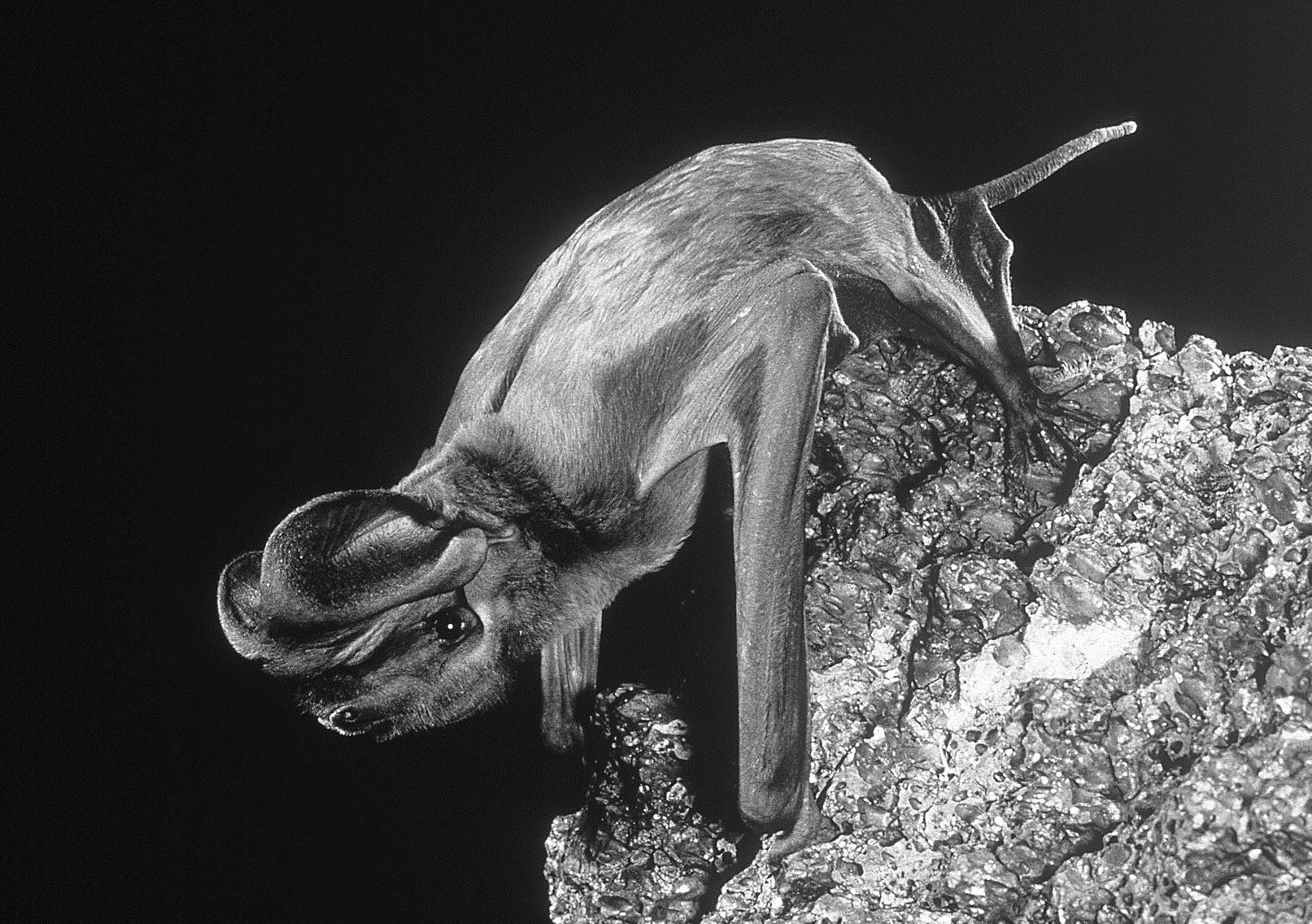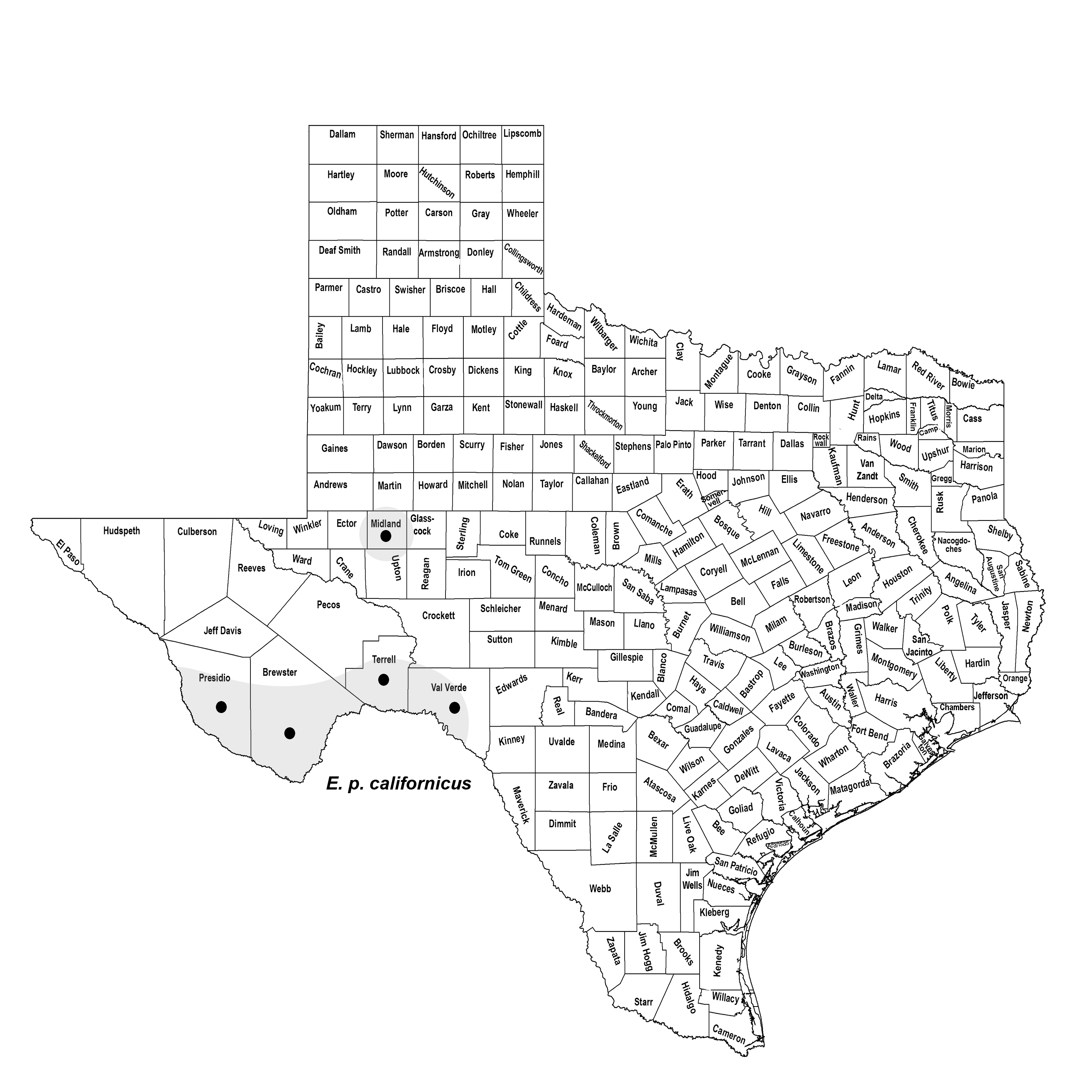WESTERN BONNETED BAT
Eumops perotis (Schinz 1821)
Order Chiroptera : Family Molossidae
DESCRIPTION. A large free-tailed bat, similar to Tadarida and Nyctinomops in general appearance but nearly twice as large; foot large, ratio of foot to tibia about 0.60; ears large, united across the forehead and projecting about 10 mm beyond the snout; second joint of fourth finger about 6 mm; pelage short and velvety; upperparts brown or grayish brown, bases of hairs whitish; underparts paler. Males have a peculiar glandular pouch on the throat. Dental formula: I 1/2, C 1/1, Pm 2/2, M 3/3 × 2 = 30. Averages for external measurements: total length, 167 mm; tail, 57 mm; foot, 17 mm; ear, 40 mm; forearm, 76 mm. Weight, 60–70 g.

DISTRIBUTION. The western bonneted bat occurs from the southwestern United States (western Texas to California) southward to northern Argentina and southern Brazil, although it has not yet been reported from Central America. In Texas it has been taken at localities near the Rio Grande in Val Verde, Terrell, Brewster, and Presidio counties. A disjunct Texas Department of State Health Services record has been reported from Midland County, suggesting this bat may be more widely distributed in our state.

SUBSPECIES. Eumops p. californicus.
HABITS. Away from human habitations, this bat generally seeks diurnal refuge in crevices in rocks that form vertical or nearly vertical cliffs. The roost entrances typically are horizontally oriented, have moderately large openings, and face downward so they can be entered from below. In Capote Canyon, Presidio County, these bats were found utilizing a crevice formed by exfoliation of the nearly vertical rim rock. There are openings on both the lower and upper edges of the slab. At this site the canyon wall is about 38 m (125 ft.) high, and the rather steep slope below the cliff has no tall vegetation that might obstruct the takeoff and landing of the bats. Most authors agree that the bats choose a roost with an unobstructed drop of several meters so that the emerging bats can drop and gain sufficient momentum to become airborne. Captive bats are unable to take off from the ground or from flat surfaces and also are unable to maintain flight after launching themselves from the tops of tables. Bats tossed 4.5 m (15 ft.) high in the air, however, are able to become airborne, but those thrown half that distance cannot.
Colony size varies from two or three individuals to several dozen. Twenty individuals
is a large colony of these bats, although colonies of up to 70 are known. In 1972,
Harry Ohlendorf counted 71 individuals as they left the Capote Canyon roost about
sunset on 30 January. The first bats emerged about 6:45 p.m. (MST), and within 10
minutes 30 of them had taken wing. During the next 15 minutes, 19 more emerged, 12
more took off during the next 10 minutes, 4 more in the next 15 minutes, and 2 more
in the last 10 minutes. Thus, the exodus of the 71 bats was strung out over a period
of 50 minutes. Just before launching themselves into flight, and during flight, the
bats utter a series of loud, shrill, chattering calls that can be heard for a considerable
distance.
These bats leave their day roosts late in the evening to forage. The stomachs of 18
bats collected in Big Bend National Park contained moths (79.9%), crickets, (16.5%),
grasshoppers (2.8%), and unidentified insects (0.7%). Hawk moths, bees, dragonflies,
leaf bugs, beetles, and cicadas have also been reported in their diet. These bats
are not believed to use night roosts but instead soar at great altitudes (up to 600
m, or 1,970 ft.) all night long so that they can feed over wide areas (up to 24 km,
or 15 mi., from the roost). Insects carried aloft by thermal currents probably furnish
an important portion of their diet. The presence of flightless insects, such as crickets,
in their diet is interesting as these bats are unable to take off from the ground
and therefore cannot alight to capture such prey. These prey items could be picked
from canyon walls as the bats forage.
Observations indicate that males and females of this species remain together throughout the year, even during the period when young are produced. A nonmigrating, nonhibernating mammal, reproductive activity occurs in the spring, with ovulation occurring soon after copulation. The gestation period is approximately 80–90 days. Normally only one young is produced per pregnancy, but occasionally a female may give birth to twins. The period of parturition is most commonly from June to early July, although young have been born as early as April and as late as August. A nursery colony may contain young ranging from newborn individuals to ones that are several weeks old. At birth the young are dull black in color.
This is the largest (forearm = 72–83 mm) bat in the United States, with adults weighing up to 84 g. The large size of this bat and the absence of vertical wrinkles on the lips along the muzzle serve to distinguish this species from the Brazilian free-tailed bat (Tadarida brasiliensis) and both species of Nyctinomops in Texas.
POPULATION STATUS. Uncommon, year-round resident. This is an uncommon, poorly known species that is a year-round resident of the Trans-Pecos region. There are only 38 specimen records from Texas.
CONSERVATION STATUS. The western bonneted bat status is listed by the IUCN as least concern in view of its wide distribution, presumed large population, and the likelihood that it is not declining at a rate required to warrant listing in a threatened category. Also, it does not appear on the official lists of concerned species published by the USFWS or TPWD. However, the lack of information on its population and apparent decline in other parts of its range (e.g., California) indicate a need to study its basic biology and population dynamics in Texas. Because of their limited maneuverability, these bats require open, unobstructed waterways for drinking. Because of this requirement, plant species such as salt cedar and mesquite, which invade riparian zones in West Texas, pose a potential threat by further constraining available water resources. Also, this bat could be very sensitive to drought conditions that restrict the number and size of watering holes in the desert and mountainous regions of Texas.
From The Mammals of Texas, Seventh Edition by David J. Schmidly and Robert D. Bradley, copyright © 1994, 2004, 2016. Courtesy of the University of Texas Press.
Natural Science Research Laboratory
-
Address
Museum of Texas Tech University, 3301 4th street, Lubbock, TX 79409 -
Phone
806.742.2486 -
Email
nsrl.museum@ttu.edu

